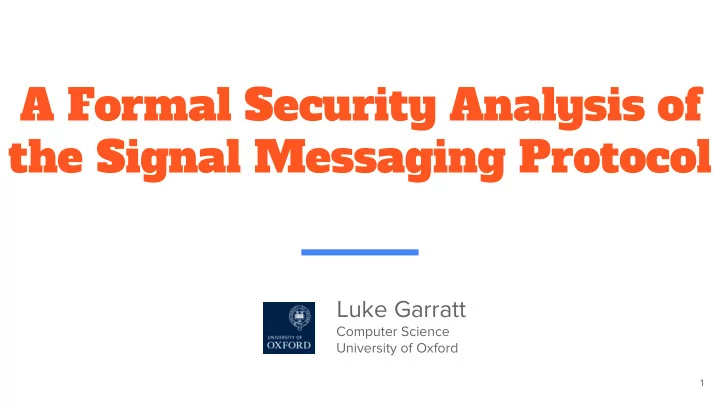

A Formal Security Analysis of the Signal Messaging Protocol Luke Garratt Computer Science University of Oxford 1
Why what is doing is . Luke Garratt Computer Science University of Oxford 2
Professors minions* Katriel Cohn-Gordon Cas Cremers Luke Garratt *PhD students Douglas Stebila 3 Ben Dowling
What should Signal achieve? Does it? 4
Forward secrecy: 5
Forward secrecy: Post-compromise security: 6
Why is this useful? 7
Why is this useful? Older protocols have no forward secrecy. (E.g. TLS-RSA) Adversary can store ciphertext traffic of target session, obtain long-term keys ● later and then decrypt. 8
Why is this useful? Older protocols have no forward secrecy. (E.g. TLS-RSA) Adversary can store ciphertext traffic of target session, obtain long-term keys ● later and then decrypt. Newer protocols have forward secrecy. (E.g. TLS-DHE) ● Adversary must now obtain long-term keys first, wait for interesting target session and then launch a man-in-the-middle attack. 9
Why is this useful? Older protocols have no forward secrecy. (E.g. TLS-RSA) Adversary can store ciphertext traffic of target session, obtain long-term keys ● later and then decrypt. Newer protocols have forward secrecy. (E.g. TLS-DHE) ● Adversary must now obtain long-term keys first, wait for interesting target session and then launch a man-in-the-middle attack. Fancy protocols have post-compromise security. (Signal?) ● Adversary must now obtain long-term keys and immediately attack and keep on attacking if it wants to compromise future targeted sessions. 10
[PCS, CSF ‘16]: “Security guarantees even after your peer’s key is compromised.” 11
Our Signal security model Adapted Bellare-Rogaway-style, multi-stage key exchange model. [1] Bellare and Rogaway, “Entity Authentication and Key Distribution”. [2] Fischlin and Günther, “Multi-Stage Key Exchange…”. 12
Our Signal security model Our model captures: ● Adversary has full network control. 13
Our Signal security model Our model captures: ● Adversary has full network control. ● Perfect forward secrecy. 14
Our Signal security model Our model captures: ● Adversary has full network control. ● Perfect forward secrecy. ● Key compromise impersonation attacks. 15
Our Signal security model Our model captures: ● Adversary has full network control. ● Perfect forward secrecy. ● Key compromise impersonation attacks. ● Some (but not all) random numbers can be compromised. 16
Our Signal security model Our model captures: ● Adversary has full network control. ● Perfect forward secrecy. ● Key compromise impersonation attacks. ● Some (but not all) random numbers can be compromised. ● Post-compromise security. 17
Main result Theorem. The Signal protocol is a secure multi-stage key exchange protocol in our model, under the GDH assumption and assuming all KDFs are random oracles. 18
19
Limitations 20
Limitations ● Theoretical analysis (not considering implementations). 21
Limitations ● Theoretical analysis (not considering implementations). ● Long-term identity key is used in initial handshake and to sign medium-term key. We just assume for simplicity that the medium term key is authentic. 22
Limitations ● Theoretical analysis (not considering implementations). ● Long-term identity key is used in initial handshake and to sign medium-term key. We just assume for simplicity that the medium term key is authentic. ● We assume honest key distribution. 23
Limitations ● Theoretical analysis (not considering implementations). ● Long-term identity key is used in initial handshake and to sign medium-term key. We just assume for simplicity that the medium term key is authentic. ● We assume honest key distribution. ● Multiple devices not considered yet. 24
[Signal, EuroS&P ‘17]: “Looks pretty good! (some caveats)” 25
Thanks for listening 1. There’s this cool new security property called “post-compromise security”. 2. Signal Protocol achieves it in addition to other security properties. 3. But there is more to investigate. [PCS] On Post-Compromise Security . Cohn-Gordon, Cremers and Garratt. CSF ‘16. ePrint link: ia.cr/2016/221. [Signal] A Formal Security Analysis of the Signal Messaging Protocol . Cohn-Gordon, Cremers, Dowling, Garratt, and Stebila. Euro S&P ‘17. ePrint link: ia.cr/2016/1013. 26
Recommend
More recommend